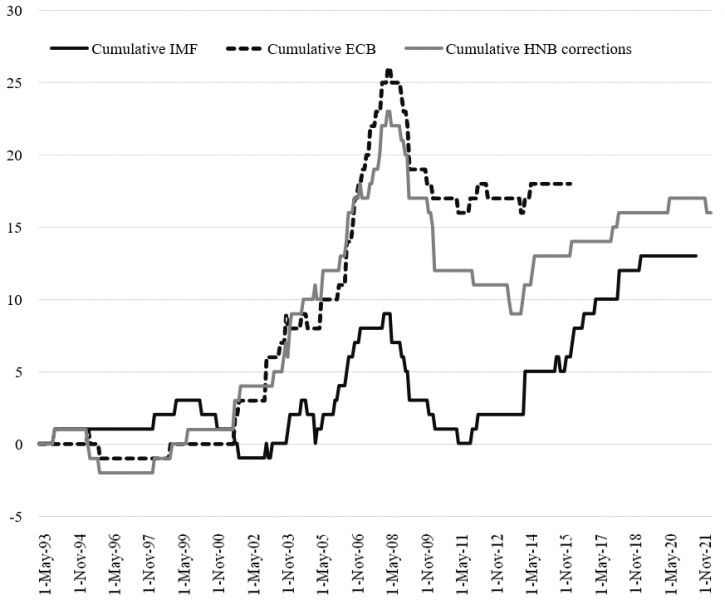References
Adrian, T., Boyarchenko, N., Giannone, D. (2016). Vulnerable growth, FRBNY Staff Report, No. 794, Federal Reserve Bank of New York.
Adrian, T., Grinberg, G., Liang, N., Malik, S., Yu, J. (2018). The Term Structure of Growth-at-Risk, IMF Working Paper, WP/18/180. International Monetary Fund.
Alessandri, P., Di Cesare, A. (2021). Growth-at-risk in Italy during the covid-19 pandemic, Notes on Financial Stability and Supervision, No. 24, Banca D’Italia.
Bayoumi, T., Quayyum, S., Das, S. (2021). Growth at Risk from Natural Disasters (September 1, 2021). IMF Working Paper No. 2021/234, Available at SSRN:
https://ssrn.com/abstract=4026436.
ECB (2018). MacroPrudential Policies Evaluation Database.
Eller, M., Martin, R., Schuberth, H., Vashold, L. (2020). Macroprudential policies in CESEE – an intensity-adjusted approach, Focus on European Economic Integration, Oesterreichische Nationalbank (Austrian Central Bank), issue Q2/20, pp. 65-81.
ESRB (2011): Recommendation of the European Systemic Risk Board, on the macroprudential mandate of national authorities. ESRB/2011/3, available
here.
ESRB (2019): Features of a macroprudential stance: initial considerations, European Systemic Risk Board, available
here.
ESRB (2021): A framework for assessing macroprudential stance. Report of the Expert Group on Macroprudential Stance – Phase II (implementation). European Systemic Risk Board, available
here.
Gächter, M., Geiger, M., Hasler, E. (2023). On the Structural Determinants of Growth-at-Risk, International Journal of Central Banking, International Journal of Central Banking, vol. 19(2), pages 251-293.
Giglio, S., Kelly, B., Pruitt, S. (2015). Systemic risk and the macroeconomy: An empirical evaluation. NBER working paper, No. 20963, National Bureau of Economic Research.
IMF (2022). Database, available
here.
Lucas, R.E. (1972). Expectations and the Neutrality of Money. Journal of Economic Theory 4(1):103-124.
McCallum, B.T. (1999). Analysis of the Monetary Transmission Mechanism: Methodological Issues NBER Working Paper 7395.
O’Brien, M., Wosser, M. (2022). Assessing Structure-Related Systemic Risk in Advanced Economies, Research Technical Paper, Vol. 2022, No. 3, Central Bank of Ireland.
Richter, B., Schularik, M., Shim, I. (2018). The costs of macroprudential policy, NBER Working paper series, No. 24989, National Bureau of Economic Research.
Richter, B., Schularik, M., Shim, I. (2019). The costs of macroprudential policy, Journal of International Economics, 118, pp. 263-282.
Vandenbussche, J., Vogel, U., Detragiache, E. (2015). Macroprudential policies and housing prices: A new database and empirical evidence for Central, Eastern, and Southeastern Europe. Journal of Money, Credit and Banking, 47(S1):343–377.


